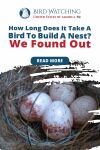
What’s This Post About?
Thanks to the cardinal’s beautiful features and striking red color, it is one of the most easily identifiable birds in the country. It is one of the most frequent guests that visit your feeder but I assure you, you will be able to find a cardinal practically anywhere.
The entire process of the cardinals mating and building nests is magnificent. Knowing about it will help you understand how they behave with the child.
After giving birth, both parent cardinals tend to the baby. Cardinals do not move their babies. They stay with them for a few weeks until they get independent. However, circumstances like a potential threat from a predator can force them to move.

The Mating Process
During mating, male cardinals show their passion for the ladies by feeding them seeds in a way known as 'beak to beak'.
Mate feeding is one of the mating behaviors you may notice at your bird feeder. The male will pick up a seed and hop up to the female, where the two will briefly contact beaks as she accepts the meal.
During the egg-laying and incubation periods of breeding, mates continue to feed each other.

Did You Know?
This behavior is what lets the female cardinal know that the male is capable of taking care of their child.
March, May, June, and July are the months for mating. To protect its breeding site, the male sings and actively attacks any intruder males. Because they only mate with the same bird each breeding season, the cardinals are considered monogamous.
The Nesting Process
The female begins to visit prospective nesting locations around two weeks before the female begins nesting. The male cardinal also accompanies her. As they inspect each place, the couple exchanges call and hold nesting material in their bills.
Cardinals are very particular about the location of their nests. They usually pick a spot that is well hidden within shrubs or low trees. They place the nests at a height of about 1-15 meters above the ground.
While the female constructs the nest, the male guards the location keeping an eye out for any threats.

The material often used while building nests are:
- Twigs
- Bark Strips
- Vine Leaves
- Rootlets
- Paper
- Grass
- Hair
The nest takes 3 to 9 days to construct; the end result is 2-3 inches tall, 4 inches wide, and has a 3-inch inner circle. Even though they spend a lot of time building their nest, cardinals aren’t known to utilize it more than once.
Pro-Tip
Plant multiple low trees if you want cardinals to stick around. They will move to a nearby location to start building a new nest once the little one gets independent.
The Incubating Process
After the nest is completed, egg-laying may begin 1 to 8 days later.
The way the parents divide responsibilities so naturally is wonderful to watch. After the nest has been built, the female will begin laying eggs any day within a week. Before the last egg is deposited, the female sits on the eggs for a brief period.
It is after the last egg deposition that the incubation process begins.
The eggs are solely incubated by the female. During this period, however, the male’s job is to feed her on the nest and defend their area from invaders.
His instincts as a father lead him to safeguard and care for the mother and young ones until they can safely leave the nest.

Post-Hatching Process
The male's brilliant red hue will typically fade to a dark shade of brown when he is providing for his brood.
When the eggs are hatched, both parents will feed the young initially. The female will then fly off to prepare a new nest for the next brood. During this time the male will continue to feed the first brood.
The brief color change from red to brown serves as a disguise during the times when he and his partner are caring for the baby cardinals.
Did You Know?
Cardinals will raise at least two broods in one season.
The first brood is normally in March, with the second following shortly after the youngsters have left the nest, in May. The young will leave the nest in 9-11 days.
After leaving the nest, young cardinals typically accompany their parents on the ground for many days.
They stick close to their parents until they can fend for themselves. Once the young get mature enough to find themselves feed, the parents leave them completely. Now the young will flock with other juveniles until they become an adult.

Do Cardinals Move Their Babies?
The cardinals do not move their babies. They will not reuse the same nest but fly away themselves to build a new nest leaving the young behind. The parents will feed their babies several weeks after they have left the nest.
You might be wondering where the eggs you saw a few days ago went knowing cardinals do not move their babies. There may be some instances where the area or the nesting site no longer feels safer. In that case, the parent cardinals might choose to relocate to a safer location.
Potential reasons that may cause the cardinals to move their babies are:
-
Predator probing the nest for an extended period
-
Insect infestation
-
Human disruptions, whether frequent or hostile, can lead to nest abandonment, and care should be made to avoid this.
-
Any attempt to remove the nest
Warning
Avoid visiting any nesting area as predators might follow a route or smell trail left by frequent human visits.
During and after the nesting process, the birds become extremely conscious of potential attacks because of the added responsibility they have. The father cardinal is on a continuous lookout to keep his family secure.
Did You Know?
Cardinals dispose of the eggs after their babies have hatched out of them. They fly with the shells far away from their nest to ensure that their location is not disclosed to any predators.
The Appearance of the Young

You will be fascinated to know that the young look exactly like the female cardinal during the early stages. Males will acquire the more noticeable black mask, crest, and red feathers seen in adult males by winter.
Until then, they have an olive-colored body with orangeish red markings as shown.
Did You Know?
Since both the juvenile and adult female cardinal look so similar, you can use the color of their beak to differentiate. The juvenile cardinal has a black beak that with time and maturity turns orange.
The Role You Can Play
Cardinals are thought to be extremely useful to people since they devour a variety of insects in gardens and like eating weed seeds.
Cardinals can be quite beneficial to have in your yard. You can do a few things to lure them to your yard and assist them through this process. This will lead the birds to feel more welcome and secure.
You can
-
Place multiple feeders
-
Plant multiple trees to allow cardinals to relocate within your yard
-
Place water baths
-
Contain any house pets like cats or dogs
Warning
Cardinals are especially vulnerable to predation by house cats because they forage on the ground. If you want the birds to feel at ease in your yard, make sure your pets are kept inside.
Pro-Tip
Even after cardinals move to a new one, do not remove the old nest. The existence of other nests helps them escape with ease from predation.
Keep Reading!
The babies are not moved by the cardinals. They will not return to the same nest, but will instead fly away to build a new one, leaving the young behind. They will, however, relocate if they are afraid of being attacked by a predator.
Since these birds do not migrate and have a tendency to produce multiple broods in one season, you might just be lucky to see the family multiply.
If you want to be able to capture this divine experience, you can read our blog about backyard bird photography.
Backyard Bird Photography: Essential Gear for Beginners - Here is Your Expert & Exciting Guide!
Here’s your expert and exciting guide to set you on course for a captivating photography experience. Backyard bird photography just got better, learn how!

By David A. Swanson
Bird Watching USA
My name is David and I'm the the founder of Bird Watching USA! I started Bird Watching with My father-in-law many years ago, and I've become an addict to watching these beautiful creatures. I've learnt so much over about bird watching over the years that I want to share with the world everything I know about them!

David A. Swanson
Bird Watching USA
My name is David and I'm the the founder of Bird Watching USA! I started Bird Watching with My father-in-law many years ago, and I've become an addict to watching these beautiful creatures. I've learnt so much over about bird watching over the years that I want to share with the world everything I know about them!









